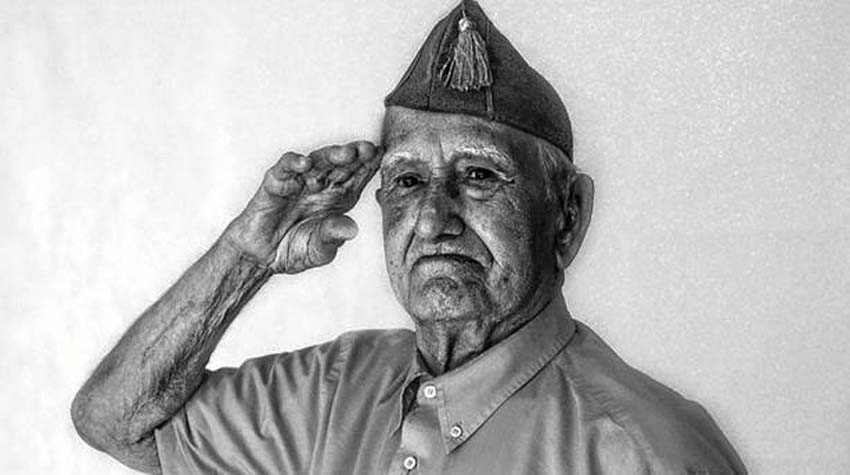Iban Gorriti. Great-grandson of Basques and Catalans in exile, the Chilean who lived in Bizkaia, Mauro Saravia (Viña del Mar, 1982) will inaugurate on March 2nd the most complete exhibit that has ever compiled on the last gudaris and living militiamen of the Basque Army of 1936, the Eusko Gudarostea.
The interesting title of the project that was conceived with the support of the memorialist association Intxorta 1937 is Azken Bataloia, the last battalion. The exhibit will be on the first floor of the General Assembly of Bizkaia, who is also one of its sponsors, on the Hurtado de Amezaga Street in Bilbao.
The photographer explained why he entitled it, Azken Bataloia. “It makes a reference that in Euskadi, when the battalions suffered many casualties, they used to be regrouped in new units. And these are the last living fighters, I don’t think that there couldn’t be a better title,” he said.
Thanks to his interest, dedication and good work, Saravia has portrayed the 26 ex-combatants anti-fascists nonagenarians and centenarians in black and white. Luckily, some of you may know of more gudaris that are still living. “I might have to expand it urgently to 28. I will try to not leave anyone out,” he added.
The portraits are different types of planes, of medium format, made with an analog camera and supported by a second camera, digital. There is also the support of the audiovisual clips of collected testimonies of the men. It is a project of “photo documentary,” he said that will end up becoming a photobook.
The role of women
This exhibit at the General Assembly is the first part of the ethnographic-memorialist initiative that has begun. “I am missing half of the story. The point of view of the women. Many times we talk about the men, how they suffered on the front and in prison, which is not to be trivialized. But, the women? What happened with them? He asks further: “Researching, I know that they were also on the front, with arms, supporting, administering, creating networks and the infrastructure so that the gudaris and militiamen could be there. The role that women played during the Civil War and in the following era in Euskadi was important. They suffered repression and massive violence towards them, both during the war and in the post-war period because of it.
With this research in conjunction with Intxorta 1937 Kultur Elkartea, the need was born to portray and collect stories of women who were retaliated against by Franquism. “I take advantage of this to invite anyone who would like to participate, be photographed, and tell your story. Especially if you were in the militia, a nurse or participated directly or indirectly in the dispute or in the retaliation of Basque origin. Please contact me through this website: www.maurosaravia.com,” he invites.
The photobook will include two parts, the gudaris and women. “I am happy because I think it will include a richer point of view.”
Even if libraries already have recommended books of biographies of the ex-combatants, this is urgent for Saravia to be the first to sign a photo exhibition that is as complete of these former combatants of the Eusko Gudarostea. “It is incredible to me that this hasn’t been done before, but it is a huge honor. Of course, not downplaying what others have done and continue to do on this subject,” he recognizes.
Experiences
One day with a gudari will make a mark on anyone. In the case of this photographer, the day with them is “very intense.” He has a working script. He contacts the family, makes an appointment, which isn’t always easy. “Once at the session, I have very little time because the models get tired and what happens is very concentrated in a very short time period. When I get home, their stories come to me, the experiences are tremendous, more than once I had trouble falling asleep.”
Each session is emotional. “A republican that constructed the Iron Belt, when the Franquistas come to Bilbao, was forcibly enlisted by the rebel army and tells me that he was on the front lines, rifle in hand shooting with his eyes closed dying inside, knowing that his brothers were in front of him.”
Adding this to a man, whose brother was shot, and was imprisoned for 21 years for his ideas, to another who never talked about the war in his life with his children, because he literally decided “to not raise them with hate.” A 14-year old child that went to fight in a ship, “knowing that if he died, nobody would claim him, since he wasn’t registered anywhere. So the owner wouldn’t have any problems.”
Objectives
The photographer is hoping that this traveling exhibit will be “seen a lot, in many places” as well as travel next year to Chile, since these stories do not go unnoticed. We have to empathize with these types of experiences so that through empathy a dialogue is created and peace is cultivated. The message is very important, war is bad, and is an atrocity, we can’t allow more wars,” Saravia insists.
During these years, some of the gudaris have passed away and some haven’t been photographed for the exhibit, something that leaves a bitter taste and reminds him of those who have left. “I feel privileged for having had the good fortune to know and share some time with these wonderful people, I can’t help feeling sad each time one of them leaves us. I understand that they have completed a cycle, but I still feel that we didn’t take full advantage of them and that we could have learned much, much more from them,” he stresses.
(originally published in Deia)






 Send to a friend
Send to a friend Add comment
Add comment








